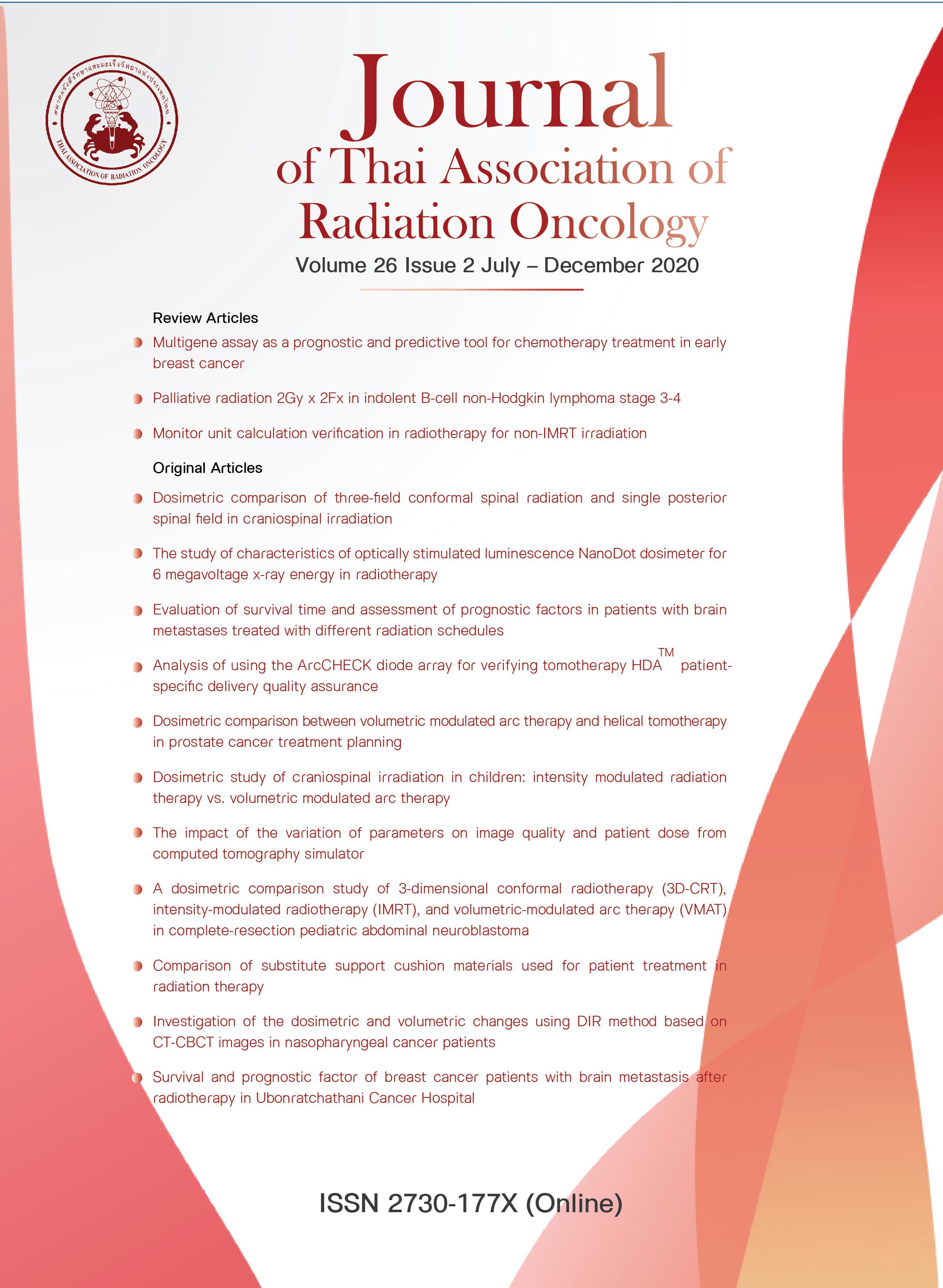Dosimetric Study of Craniospinal Irradiation in Children: Intensity Modulated Radiation Therapy vs. Volumetric Modulated Arc Therapy
Keywords:
Craniospinal Irradiation, Pediatrics, Radiation Therapy, Volumetric Modulated Arc Therapy, Intensity Modulated Radiation TherapyAbstract
Background: Long-term craniospinal irradiation (CSI)-related toxicities are the major concerned in pediatric medulloblastoma. To reduce the risk to normal structures, the more conformal radiation therapy is preferred.
Objective: To evaluate and compare the dosimetric parameters of CSI between intensity modulated radiation therapy (IMRT) and volumetric modulated radiation therapy (VMAT) in terms of target coverage and normal tissue sparing in pediatric patients with standard risk medulloblastoma.
Materials and Methods: Ten children with medulloblastoma previously treated with three-dimensional conformal radiation therapy (3D-CRT) CSI were included in this study. All the planning computed tomography (CT) scans were performed in the supine position with a customized thermoplastic mask on a head rest set. CSI was performed with IMRT and VMAT for each child. Both plans were compared.
Results: IMRT achieved better target coverage. However, more than 95% of the volume of the planning target volume (PTV) was covered by 95% of the prescribed dose for both plans. VMAT achieved better dose homogeneity and conformity. Doses to the OARs complied with the institutional protocol except for the doses to the eyes, lens, and thyroid for both IMRT and VMAT. Due to the lack of an institutional protocol for plan optimization at the time of study, the doses to these organs did not get enough concern. No difference in mean dose to non-target tissues was found between IMRT and VMAT (p = 0.101). The mean monitor units (MU) value of VMAT was significantly lower than that of IMRT (p < 0.05).
Conclusions: With the same protocol compliance of target coverage and dose to OARs, VMAT is preferred due to its higher conformity, better dose homogeneity, and use of lower MU.
References
McGovern SL, Grosshans D, Mahajan A. Embryonal brain tumors. Cancer J. 2014;20:397-402.
Chhabra A, Mahajan A. Treatment of common pediatric CNS malignancies with proton therapy. Chin Clin Oncol. 2016;5:49.
Huang TT, Chen Y, Dietz AC, Yasui Y, Donaldson SS, Stokes DC, et al. Pulmonary outcomes in survivors of childhood central nervous system malignancies: a report from the Childhood Cancer Survivor Study. Pediatr Blood Cancer. 2014;61:319-25.
Christopherson KM, Rotondo RL, Bradley JA, Pincus DW, Wynn TT, Fort JA, et al. Late toxicity following craniospinal radiation for early-stage medulloblastoma. Acta Oncol. 2014;53:471-80.
Ribi K, Relly C, Landolt MA, Alber FD, Boltshauser E, Grotzer MA. Outcome of medulloblastoma in children: long-term complications and quality of life. Neuropediatrics. 2005;36:357-65.
Mahajan A. Proton Craniospinal Radiation Therapy: Rationale and Clinical Evidence. Int J Part Ther. 2014;1:399-407.
Al-Wassia RK, Ghassal NM, Naga A, Awad NA, Bahadur YA, Constantinescu C. Optimization of Craniospinal Irradiation for Pediatric Medulloblastoma Using VMAT and IMRT. J Pediatr Hematol Oncol. 2015;37:e405-11.
Lee YK, Brooks CJ, Bedford JL, Warrington AP, Saran FH. Development and evaluation of multiple isocentric volumetric modulated arc therapy technique for craniospinal axis radiotherapy planning. Int J Radiat Oncol Biol Phys. 2012;82:1006-12.
Suntornpong N, Tuntipumiamorn L, Iampongpaiboon P, Liammookda P. Pilot Study: A Comparison of Dose Distribution between 3-Dimensional Conformal and Intensity Modulated Radiation Therapy for Craniospinal Irradiation in Medulloblastoma. ASEAN-JR. 2012;18:137-44.
Feuvret L, Noel G, Mazeron JJ, Bey P. Conformity index: a review. Int J Radiat Oncol Biol Phys. 2006;64:333-42.
Constine LS, Ronckers CM, Hua CH, Olch A, Kremer LCM, Jackson A, et al. Pediatric Normal Tissue Effects in the Clinic (PENTEC): An International Collaboration to Analyse Normal Tissue Radiation Dose-Volume Response Relationships for Paediatric Cancer Patients. Clin Oncol (R Coll Radiol). 2019;31:199-207.
Seravalli E, Bosman M, Lassen-Ramshad Y, Vestergaard A, Oldenburger F, Visser J, et al. Dosimetric comparison of five different techniques for craniospinal irradiation across 15 European centers: analysis on behalf of the SIOP-E-BTG (radiotherapy working group). Acta Oncol. 2018;57:1240-9.
Downloads
Published
How to Cite
Issue
Section
License
บทความที่ได้รับการตีพิมพ์เป็นลิขสิทธิ์ของวารสารมะเร็งวิวัฒน์ ข้อความที่ปรากฏในบทความแต่ละเรื่องในวารสารวิชาการเล่มนี้เป็นความคิดเห็นส่วนตัวของผู้เขียนแต่ละท่านไม่เกี่ยวข้องกับ และบุคคลากรท่านอื่น ๆ ใน สมาคมฯ แต่อย่างใด ความรับผิดชอบองค์ประกอบทั้งหมดของบทความแต่ละเรื่องเป็นของผู้เขียนแต่ละท่าน หากมีความผิดพลาดใดๆ ผู้เขียนแต่ละท่านจะรับผิดชอบบทความของตนเองแต่ผู้เดียว




